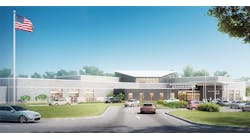CPTED principles and strategies can result in safe, orderly and comfortable schools.
The physical environment can dramatically affect feelings, behavior and the way in which we view others. It also can affect the safety and perceived safety of those who use the environment. Conscientious design, appropriate use and good maintenance of properties can promote positive social interaction, orderly behavior and increased perceptions of safety. These assertions are the basis of an evolving body of knowledge and public-safety initiatives referred to as Crime Prevention Through Environmental Design (CPTED).
CPTED principles and strategies can result in safe, orderly and comfortable schools. These strategies also can minimize the effect of target hardening and “high-tech” security measures, which students may perceive as creating a fortress- or prison-like atmosphere. As an added benefit, many CPTED strategies enhance a school's aesthetic qualities and bolster the sense of pride that students, faculty, administrators, parents and community members have in the school.
To use CPTED effectively, a school needs to involve those responsible for school design, use and maintenance. The National Crime Prevention Council (NCPC), which offers CPTED training, says schools should include designers, administrators, facilities personnel, law-enforcement officials, teachers and students as they identify and develop appropriate strategies.
ENVIRONMENTAL CONDITIONS
Conditions and behaviors in a school can create either apprehension and fear or a sense of comfort and order. When asked what physical conditions create feelings of a lack of safety, most people respond with the factors that follow.
Environmental conditions that create apprehension, fear and an unsafe environment:
-
Isolation; dim or dark areas; deserted or seldom-used spaces; vacant or abandoned buildings; Unkempt areas (litter, weeds); unsecured entrances or exits; signs of vandalism (graffiti, broken windows); disorientation; crowding and congestion; areas hidden from view; and no optional routes.
Behavior that increases apprehension and fear:
-
Inappropriate behavior; disorderly behavior; and illegal activities.
Associated factors that decrease comfort and a sense of security:
-
Lack of authority; no source of assistance; inconsistent enforcement of standards and rules.
On the other hand, environmental conditions that foster feelings of safety, order and comfort include:
-
Good lighting; occupied, actively used buildings; well-maintained areas; secured entrances and exits; signs of caring (art, murals, gardens, landscaping); clear orientation; adequate and predictable room for movement; adequate sightlines; and alternative paths.
Behavior that increases comfort and a sense of security:
-
Appropriate behavior; orderly behavior; and legitimate activities.
Associated factors that increase comfort and a sense of security:
-
Presence of authority, and access to assistance.
SCHOOL STRATEGIES
CPTED tries to decrease the conditions perceived as unsafe and increase the conditions perceived as safe. The school program uses six basic strategies — natural surveillance, access management, territoriality, physical maintenance, order maintenance and activity support.
-
Natural surveillance
This is design and placement of physical features in such a way as to maximize visibility. These features include windows, walkways, assembly areas, corridors, stairways, doors and lighting. The objective is to provide an environment in which you can see and be seen, to eliminate hiding or hard-to-see places, and thereby increase the perception of a human presence. For instance, in choosing landscaping material, schools should make sure that the material provides benefit without blocking views.
-
Access management
This is the physical guidance of people coming and going from a space. Examples include the judicious placement of signage, entrances, exits, fencing, landscaping, lighting and other way finding elements, such as the use of color, to provide orientation and direction. The objectives of access management are to keep people on safe routes, enhance emergency response, decrease the sense of being lost, avoid conflicts and prevent trespassing.
-
Territoriality
This is the use of physical attributes that delineate space and express ownership. Attributes include art, displays, signage, landscaping, fencing and pavement treatments. Also, buildings and other features can be placed so they create a perceived area of influence, similar to the concept of circling the wagons. The objectives are to increase the sense of pride and ownership felt by the students, faculty and school personnel, and put others on alert that they are coming into territory that is owned and cared for. This gives the message that unacceptable behavior will not be tolerated.
Two critical components of territoriality in the school environment are involving students in the choice of displays and other features, and the physical representation of all student groups (based on class levels, interests, cultural backgrounds and other categories) which can foster a sense of inclusion.
-
Physical maintenance
This is the repair, replacement and general upkeep of the grounds and buildings. It allows for the continued use of a space for its intended purpose and serves as an additional manifestation of ownership and caring. Conversations held with students reveal a surprising amount of disdain for broken windows and doors, stained ceiling tiles and other signs of physical decay. These unkempt features heavily influence their perceptions of their schools and their sense of importance to the school and community.
-
Order maintenance
This is attention to and reduction of minor undesirable acts. Expectations regarding behavior are clearly stated and consequences for unacceptable behavior are known and consistently applied. Examples of order maintenance include clarifying rules of behavior related to the cafeteria, lockers, backpacks, outside areas, parking lots, buses, parent pickup, emergency procedures and recreational events. The objective is to maintain and encourage behavior that is orderly and predictable, thereby preventing the escalation of tension and conflicts.
-
Activity support
This is the planning and placement of activities that promote human presence. It enhances opportunities for casual surveillance and access management. Examples include supervised recreation or physical-education activities, the judicious placement of outside dining areas, staff parking, teacher's lounge, administrative offices and school resource officer parking spaces. With activity support there is no specific plan to watch for undesirable activity, but the perception of surveillance is communicated by the location of the activity. Activity support may require planned provisions of space for programs, gatherings and other events.
ADDITIONAL FACTORS
Associated with the six core strategies are additional factors related to the environment and human behavior. They include the need for natural light, fresh air and live plants, which is called access to nature; ease of communication with and among staff members; and the relationship with the surrounding community.
Using common physical elements and routine activities helps schools create and maintain a safe, orderly and comfortable environment. CPTED strategies reduce the need for expensive and oppressive security equipment, enhance the aesthetics of the school building, and provide an environment in which students feel and are safe.
Sherry P. Carter, AICP, and Stanley L. Carter, of Carter & Carter Associates, Sarasota, Fla., developed the Safer School and Communities by Design training curriculum for the National Crime Prevention Council.
About the training
“Safer Schools and Communities by Design: The CPTED Approach” is available from the National Crime Prevention Council. The three-day program is designed for architects, law-enforcement officers, planners, school administrators, faculty and students. The program includes technical sessions on CPTED and the physical environment; a CPTED assessment of selected schools; and team presentations and discussions. (20 CEUs are available for architects.) For more information, contact Joanna Cassarino at (202)261-4170 or [email protected].

